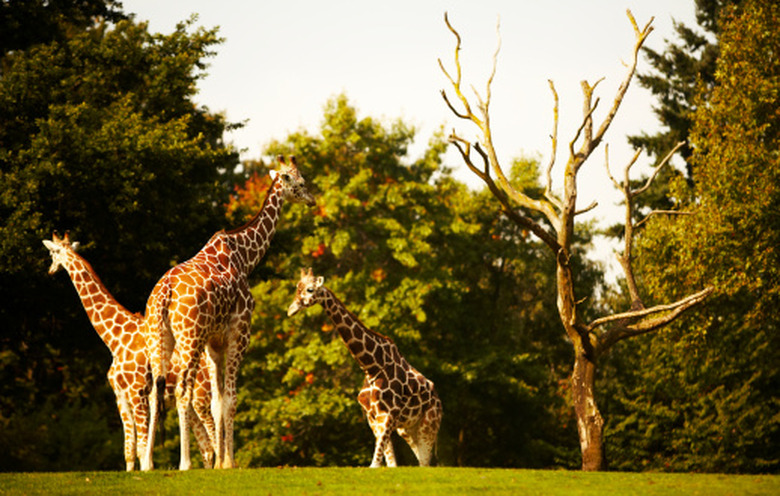The Giraffe's Adaptation In The Grasslands
The tallest land animals in the world and the largest of Earth's grazing ungulates, giraffes (Giraffa camelopardalis) live in the savanna grasslands of sub-Sarahan Africa. Giraffes exhibit several characteristics developed through their evolution in a grassland environment in which scattered trees offer a food source most other species cannot utilize, water can be scarce and predators abound.
Long Neck
Long Neck
Giraffes' famously long necks allow them to browse leaves off the tops of grassland trees, helping them avoid food competition from other herbivores. A giraffe's neck can be up to 6 feet long. Their long necks also provide a height advantage for spotting predators, so other grassland prey species look to giraffes as sentinels for danger. A number of other anatomical and physiological adaptations help make their long necks possible. For example, a large heart and lungs are necessary to pump blood to the brain and expel used air from the windpipe. According to The Science Creative Quarterly, many researchers believe sexual competition might also contribute to the evolution of the giraffe's long neck, because male compete for mates through a form of neck wrestling.
Strong Tounge
Strong Tounge
A giraffe's tongue is well-adapted to acquiring leaves in the savanna. The giraffe's tongue is the strongest of any animal and is exceptionally long at 18 inches. Their tongues are also prehensile, allowing for accurate use. According to the San Diego Zoo, scientists believe the dark coloring of the giraffe's tongue helps protect it from the harsh savanna sun.
Saliva
Saliva
Giraffes have a thick coating of glue-like saliva in their mouths. The saliva protects the animals from injuries from sticks and thorns, allowing them to consume grassland vegetation that is inedible to other species. Acacia trees, a common grassland tree species, is one of the giraffe's favorite foods. Acacias are armored with spiky thorns, but strong prehensile tongues and protective saliva allow them to eat the tree's leaves.
Water Needs
Water Needs
Giraffes acquire much of their water needs from food and from morning dew. They are also able to go for long periods without water and can gulp water quickly when needed. A giraffe can consume up to 10 gallons of water at one time. Being able to go without water is useful during the dry seasons on the savanna. Drinking large amounts of water quickly helps limit the time giraffes are vulnerable to attack from their main predators: lions and crocodiles.
Camouflage
Camouflage
The giraffe's patterned spots and light tan to dark brown coloring help camouflage the animal in the grassland environment. Although their large size and defensive kicking abilities protect them from most savanna predators, babies are at risk and require the extra protection their camouflage offers. The first few months of a giraffe's life are its most vulnerable, as lions, hyenas, hunting dogs and leopards will prey on young giraffes, according to the Giraffe Conservation Foundation.
Cite This Article
MLA
Cummings, Eliza. "The Giraffe's Adaptation In The Grasslands" sciencing.com, https://www.sciencing.com/giraffes-adaptation-grasslands-8208751/. 22 November 2019.
APA
Cummings, Eliza. (2019, November 22). The Giraffe's Adaptation In The Grasslands. sciencing.com. Retrieved from https://www.sciencing.com/giraffes-adaptation-grasslands-8208751/
Chicago
Cummings, Eliza. The Giraffe's Adaptation In The Grasslands last modified March 24, 2022. https://www.sciencing.com/giraffes-adaptation-grasslands-8208751/
